)_tankless.jpg?cx=1265&cy=0&cw=468&ch=625)
All About Tankless Water Heater Installation
Installation
Tankless water heaters may use less fuel than conventional water heaters depending on usage and provide on demand hot water. They’re compact, and you can install them right next to where you need hot water.
Installation of a tankless heater is relatively straightforward, but you must observe applicable local and national codes and have the unit installed by a qualified installer.
Tankless Water Heaters
A tankless water heater is a compact unit that heats water as you need it. The heater does not have a water storage tank.
When you turn on a hot water faucet, a sensor detects water flow and activates the heating unit. This may be a gas, propane or electric tankless water heater.
The cold water passes through a small but very efficient heat exchanger if gas or over elements if electric and is almost instantly heated to the correct temperature. Tankless water heaters have control units that regulate the water temperature and monitor safe operation.
Advantages of a Tankless Heater
A tankless water heater has many advantages over traditional hot water tanks.
Never Run Out of Hot Water
You will never run out of hot water as long as you do not exceed the flow rate. A tankless water heater continually heats the water running through the faucet.
Longer Lifespan Than a Traditional Tank Heater
Tankless water heaters can last up to twice as long as hot water tanks. They typically use corrosion-resistant copper or stainless-steel heat exchangers and don't have a water storage tank that can corrode.
According to Energy.gov, most units have a life expectancy of over 20 years although they do require periodic maintenance to have a long life.
In fact, many A. O. Smith gas tankless water heaters come with X3® Scale Prevention Technology to deliver continuous hot water, while protecting against scale build-up, meaning virtually zero lifetime descaling maintenance and up to $2,800 in maintenance cost savings over the life of the product.


Reliability and Ease of Repair
These units are reliable and easy to maintain and repair. You can replace most components easily, and controllers feature self-diagnostic capabilities.
Efficiency
Because they don't store hot water, tankless water heaters are more efficient than hot water tanks. They only use energy to heat water when water is in use.
Depending on your water usage, Energy.gov reports that:
- Small on-demand heaters are between 24% and 34% more energy efficient than storage tank heaters.
- In homes that use a lot of hot water, you can expect energy savings of between 8% and 14%.
Can Be Installed Outdoors
You can install certain models outdoors. An outdoor installation helps when you have limited space inside and allows you to place the water heater conveniently close to your hot water faucet. It also simplifies venting arrangements with a gas tankless water heater installation.
Before You Begin: Things to Consider
There are several factors to consider when choosing a tankless water heater. These include features such as the size and capacity of the unit, whether to pick a gas or electric unit and the cost to install a tankless water heater. Another aspect is finding a professional installer and supplier near you.
Search our directory of certified plumbing contractors to help with professional installation.

Gas vs. Electric Tankless Water Heaters
The choice between gas and electric tankless water heaters depends in part on the availability of natural gas or propane, the amount of hot water you need, and the cost of energy in your area. Gas tankless water heaters can be more efficient depending on usage, but the tankless water heater installation cost is usually higher for gas models. Other factors to weigh include emissions, the amount of hot water you need, and the cost of upgrading to a tankless heater.
Gas Tankless
Gas tankless water heater units are efficient. Installation requirements include a suitable gas supply, an electrical connection, an air intake ventilation system, and plumbing. Consider these key points for a gas tankless water heater installation.
Fuel Type
Depending on the model, some heaters are configured for natural gas and others for propane. It’s important to specify the correct fuel, as the combustion requirements for natural gas and propane differ. Propane has a greater heat output than natural gas, but the lower cost of natural gas typically offsets this difference. Electric Tankless water heaters are also available but recover slower and provide less hot water than gas tankless water heaters.
Upgrading the Gas Line and Size
Tankless gas water heaters have larger input burners than gas-heated hot water tanks. If you’re upgrading, you’ll most likely need to increase the size of your gas line from the manifold.
Electric tankless water heaters will draw more amps compared to electric tank style water heaters and will require a bigger breaker and larger service wire.
Condensing Technology
Standard gas tankless heaters (non-condensing) have a single copper heat exchanger, while condensing units have a second stainless steel heat exchanger that extracts additional heat from the hot gas. Although condensing tankless heaters cost a bit more, they’re more efficient than non-condensing units.
Max BTU Input
The maximum BTU input determines the amount of hot water the water heater can produce. You need a higher BTU input for the same amount of hot water in northern states or at high elevations where the water is colder.
Emissions
Certain states and districts require that gas water heaters comply with low NOx and ultra-low NOx emission standards. NOx stands for nitrogen oxides, primarily nitrogen dioxide, that contribute to acid rain formation.

ENERGY STAR Certified
ENERGY STAR certified gas tankless water heaters achieve a thermal efficiency of at least 90% and use around 50% less energy than standard tank water heaters. In certain states, you may qualify for a rebate on the cost of an ENERGY STAR certified water heater.
LEED Rating
The Leadership in Energy and Environmental Design program is a method for rating green buildings. Benefits of a LEED rating include tax incentives, lower operational costs, less energy use and lower carbon emissions, along with improved air quality.
Product Line
Many gas water heaters comply with the LEED requirements. These include A.O. Smith Proline® XE gas tank water heaters and Proline® XE tankless condensing water heaters with X3 scale-reducing technology.
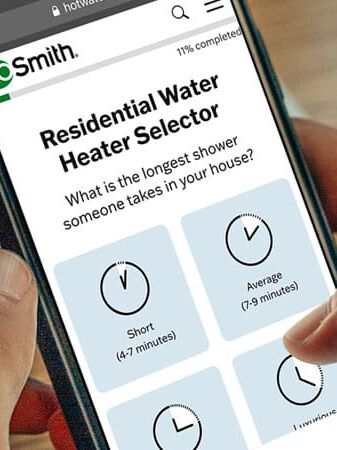
Not sure which water heater is right for you?
Take our water heater selector quiz to find the correct water heater for your home.

Electric Tankless
An electric tankless is simpler than the equivalent gas water heater. The only requirements are for a robust electrical supply and plumbing. Important points to consider include the following.
Number of Elements
The number of elements used in electric tankless heaters is two or four. The actual number depends on the flow rate of the device.
Maximum Wattage
The water heating capacity is determined by the total wattage of the elements. These vary from 12.2 kW up to 32 kW, depending on the output capacity of the water heater.
Amperage
Smaller 12.2 kW electric tankless water heaters draw 51 amps on a 240-volt supply. The largest electric tankless water heaters (32 kW) draw 133 amps at 240 volts or 135 amps at 208 volts.
Breaker and Wire Size
Smaller electric water heaters operating at 240 volts require one 60-amp breaker. Larger units and 208-volt models have two electrical circuits and require two double-pole breakers. Breaker sizes vary from 40 amps to 70 amps. The recommended wire size for current electric tankless heaters is 6-gauge copper wire, with a current rating of 65 amps, but 8-gauge wire is permitted on certain models. Always refer to the installation manual.
Flow Rate
Flow rate is the maximum volume of hot water a tankless water heater can supply to meet the highest instantaneous demand in your home. It’s best to slightly oversize the water heater, as a unit that is too small will not consistently supply sufficient hot water.
UEF Rating
The Uniform Energy Factor is a measure of your water heater's energy efficiency. A higher value means that the water heater is more efficient than a water heater with a lower rating.
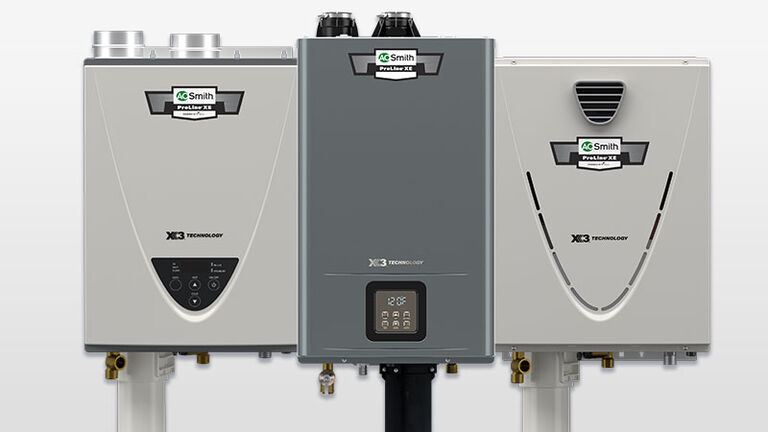
Tankless Hot Water Applications
The hot water requirements for residential and commercial establishments differ.
Residential
Residential tankless heaters are usually located closer to the point of use and have the ability to supply the maximum volume when everyone is using hot water. Residential systems typically use one, two or three tankless water heaters to meet the hot water requirements of the home.
Commercial
Commercial applications frequently require higher volumes of hot water. It’s often advisable to use multiple units installed on a multi-link rack. Commercial systems are generally more complex than residential systems.

Installation Considerations
Points to consider when installing a tankless water heater include the installation location, the complexity of the installation and whether you need a professional to install the system.
Removal and Disposal of the Old System
Depending on the condition and location of your old system, you may need to remove it before proceeding or leave it in place until the new unit is ready. You can dispose of the old unit at a recycling center or local scrapyard.
Location
It's best to locate an on-demand tankless hot water unit as close as possible to the point of use. The only exception is for whole-home applications, where you need to locate the unit centrally.
Indoors
If you’re using a gas or propane water heater, you must make allowance for the vent line and ensure you comply with vent termination clearance requirements.
Outdoors
Outdoor installations offer more flexibility, but make certain you buy a tankless water heater that is rated for outdoor use. You should also ensure the unit is protected against the weather and freezing, especially electrical models.
Complexity of the Installation
Assess the complexity of the installation. You may need to upgrade your gas lines to cope with the increased flow or your electrical supply to handle the very high current required for electric tankless water heaters. Check out our support resources for more information. Remember the new installation must comply with local and national codes.

Professional vs. DIY Installation
Carefully consider the implications of a DIY solution compared to a professional installation. Unless you have the expertise to install a tankless water heater and follow local codes, an authorized professional may likely be the best solution. Consider the following points.
Safety and Peace of Mind
Professional installers have the training and certifications to make a safe and compliant installation and give you peace of mind.
Experience and Expertise
Professional installers have the product knowledge and expertise to select and properly install the right tankless water heater for your home.
Saves Time
You will save time by using a professional installer because they have access to the right tools and components to complete the installation quickly.
Ensures Quality Work
Our approved professional installers guarantee the quality of their work and will stand by our warranty.
Establishes a Relationship for Future Repairs and Maintenance
Using a qualified installer means you know who to call for repairs and maintenance.
How to Install an Electric Tankless Water Heater
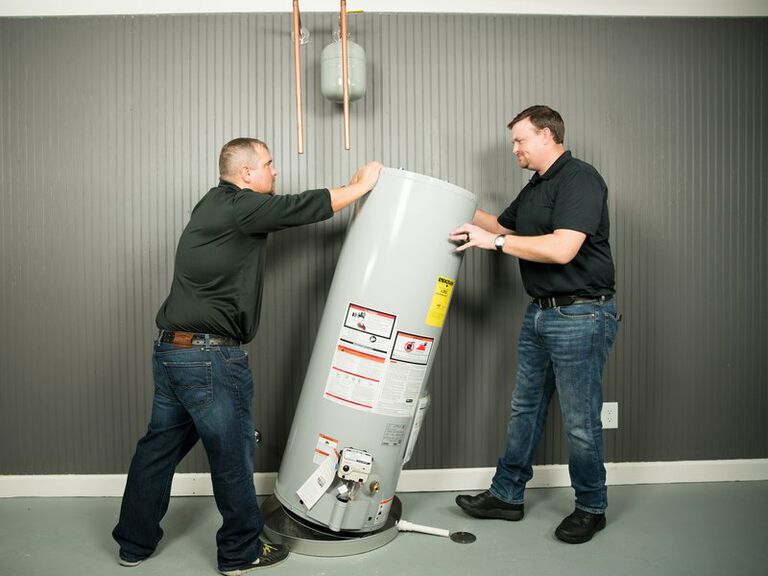
Before starting work, check that you have the tools and materials you need. Choose a clean, dry location to install the heater and determine the best routes for plumbing and electrical connections. Be aware of the risks of electrical shock and work safely. Read the owner's manual carefully before starting.
Find the specific product literature for your A. O. Smith model.
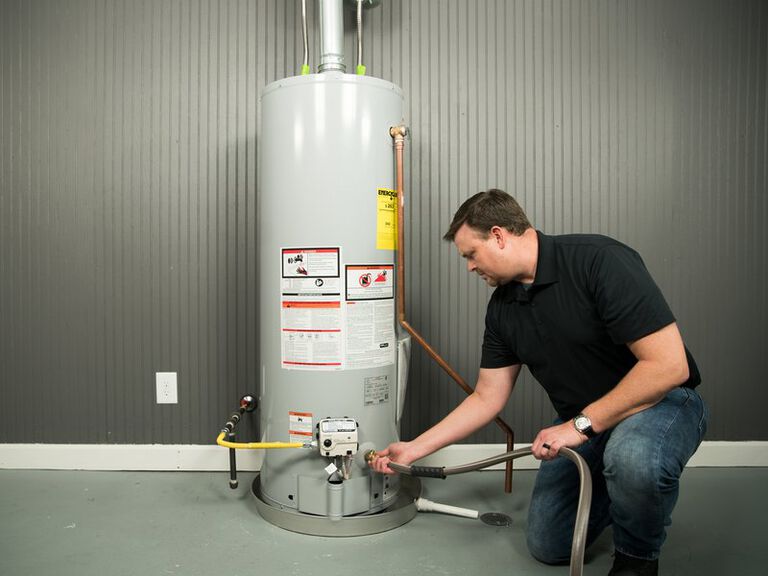
Step 1: Turn Off the Circuit Breaker and Water Supply
Switch off the electrical supply to the old water heater. Run the water through a nearby faucet until the water is cold. Turn off the water supply to the old heater. Isolate the power supply to the heater by opening the circuit breaker or pulling the fuses. Some units may have more than one breaker, so use a voltage tester to verify you have disconnected all power sources.
Step 2: Drain the Old Tank, Disconnect and Remove
Connect a length of garden hose to the drain valve and drain the tank. If the old tank is in the basement, you may need a small portable pump. Open some faucets so you don't draw a vacuum on the tank. Once empty, disconnect the water pipes and electrical connections and remove the old heater for disposal.

Step 3: Remove the Front Panel or Cover From the New Unit
Remove the tankless water heater from its packaging and remove the front cover. Disconnect the user interface display before removing the cover.
Step 4: Measure and Mount the Water Heater
Check the necessary clearances around the unit. You’ll find this information in the installation manual. Once satisfied, mount the tankless water heater on the wall, using the supplied standoffs (for two- and four-chamber water heaters).

This image is only being used as example and may not reflect the specific unit or part that you may be troubleshooting.
Step 5: Install and Connect Water Supply Lines
Connect the inlet and outlet water lines. Use flexible lines so as not to put undue strain on the water heater components. If your water pressure exceeds 80 psi, install a pressure-reducing valve.
Step 6: Attach Temperature and Pressure Relief Valves
You don't normally require a temperature and pressure relief valve, except where required by local ordinances. If required, install a thermostatic mixing valve to further regulate the water temperature.

Step 7: Turn on the Water and Purge Air From the Pipes
Turn on the water supply, and check for leaks. Purge the water lines of air by running water through all hot water faucets connected to the tankless water heater.
Step 8: Create and Verify Electrical Connections
Determine the wire size and amperage from the installation manual. Verify that your breaker box has sufficient capacity to accommodate the water heater load. Switch off the supply to the breaker box before working on the panel. Install the breakers and connect the wiring to the heater. Ensure you have a proper ground connection. Ensure the installation complies with local codes or, in their absence, with the National Electrical Code NFPA 70 (USA) or CSA C22.1 (Canada).

Step 9: Reattach the Front Panel
Reconnect the user interface display, taking care to insert the ribbon cable in the correct orientation. Reattach the front panel.
Step 10: Switch on the Circuit Breaker, and Follow the Start-Up Procedure
Perform a last check to ensure all water connections are secure and tight, that the panel is correctly attached and that the electrical cables are secure. Open the water supply to the water heater and energize the electrical supply. Follow the start-up procedure in the owner's manual.
How to Install a Gas Tankless Water Heater

Installing a tankless gas water heater requires careful attention to detail. It’s important to take great care to avoid gas leaks and to install vents correctly. For safe operation, you must follow the installation instructions in the manual. The installation must comply with local codes or, in their absence, the National Fuel and Gas Code (ANSI Z223.1/NFPA 54) in the USA or the B149.1 Natural Gas and Propane Installation Code for Canada. This installation must be performed by a qualified installer.

This image is only being used as example and may not reflect the specific unit or part that you may be troubleshooting.
Step 1: Turn off the Gas and Water Supply Lines
Before proceeding, you must turn off your gas supply at the main gas supply shutoff valve and close your water supply line at the closest stopcock valve.
Step 2: Upgrade the Gas Line If Necessary
If you’re replacing a gas-fired or electrical hot water tank, you may need to upgrade your gas line. The size of the supply line must comply with the requirements of local or national codes and should consider the distance of the gas heater from the main gas manifold. Find detailed information by downloading support literature for your model.

Step 3: Plan the Vent System
Carefully plan the vent system. Some units use concentric vents, and others have separate inlet and exhaust vents. Concentric vents must have a condensate trap. You must observe the minimum clearances specified in the manual and avoid exhausting air in any location near air intake devices. Horizontal sidewall and vertical roof vents are permitted, and it's best to keep the vent length to a minimum. Do not use the old vent lines. Refer to the manual for proper vent requirements.
Step 4: Drain and Disconnect the Old Tank
Drain the old hot water tank. Turn off and disconnect the gas supply and water lines. Remove the old unit and safely dispose of it at a recycling center or scrapyard.

This image is only being used as example and may not reflect the specific unit or part that you may be troubleshooting.
Step 5: Measure and Mount the New Heater
Choose a suitable location for mounting the tankless heater. Note the required horizontal and vertical clearances around the unit, and fasten the unit to the wall. Note that you cannot install outdoor units inside your home.
Step 6: Connect the Gas Line
Install a gas shutoff valve and connect the gas line to the heater. Make certain to install a sediment trap to prevent dirt from entering the gas burner.

This image is only being used as example and may not reflect the specific unit or part that you may be troubleshooting.
Step 7: Attach New Water Lines
Install a manual shutoff valve on the cold-water line and install new inlet and outlet water lines. Flush the water line to remove any dirt before connecting the line to the heater. To reduce the risk of scalding, a thermostatic mixing valve is recommended. Isolation valves are also recommended. A cold water shutoff is required by most codes.
Step 8: Install the Pressure Relief Valve
You must install a pressure relief valve directly after the hot water outlet on the heater. Note that normally, a pressure relief valve is required. The pressure relief valve must be rated for 150 psi, and discharge piping to the drain must be fitted.
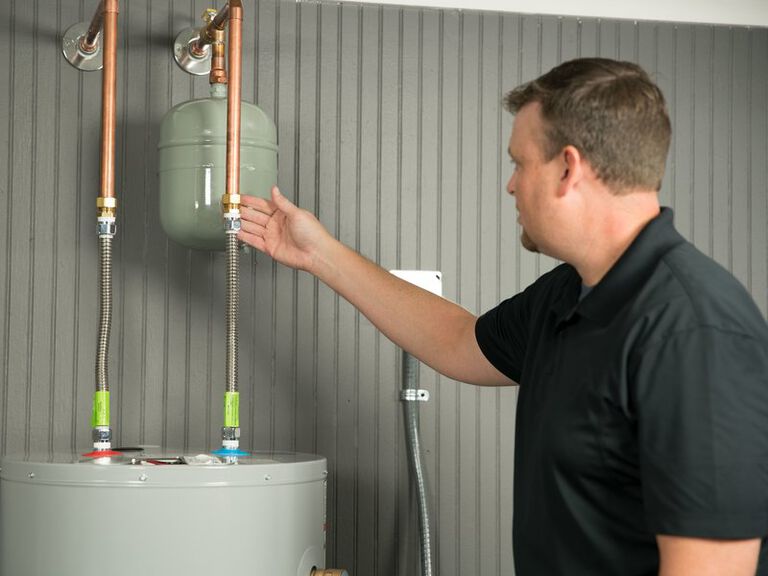
This image is only being used as example and may not reflect the specific unit or part that you may be troubleshooting.
Step 9: Recirculation Applications
If recirculation is used, an appropriately sized expansion tank must be fitted on the cold-water recirculation line, along with check valves.
Step 10: Check Water and Gas Lines for Leaks
Turn on the water line and check for and repair any leaks. Similarly, turn on the gas line and check for gas leaks. Use a gas detector to check for leaks, or apply soapy water to all connections to check for escaping gas bubbles. Turn the water and gas supply lines off after completing the leak test.

Step 11: Install the Exhaust Vent
Install the gas vent line. For indoor applications, you should also have an inlet air vent. Some tankless water heaters use concentric vents that combine the functions of an exhaust vent and an inlet vent, while others have separate vent lines. Follow the installation recommendations in the manual.
Step 12: Purge Air From Water Lines
Turn the water supply back on and purge air from the water lines by opening all faucets and running the water until there are no more air bubbles.
Step 13: Start Up the Water Heater
With the water supply on, turn on the gas and connect the tankless heater to the power by closing the circuit breaker. Calibrate the unit for the installation by adjusting the DIP switch settings according to the guide in the manual. Press the on/off button and test for normal operation by turning on a hot water faucet.
Ready to Install Your Tankless Water Heater?
A tankless water heater is an economical and efficient way to provide instant hot water where and when needed. While a tankless hot water heater installation is relatively straightforward, it’s extremely important that the work is carried out safely and professionally, in accordance with relevant local and national codes. Improper installation can void your warranty and create a risk of fire or asphyxiation.
Frequently Asked Questions
While DIY installation is technically possible if you have expertise, tankless water heaters should be installed by qualified professionals for safety and code compliance. Gas installations require proper venting and gas line upgrades, while electric models need high-amperage electrical work with appropriate breaker sizing. Professional installers ensure safe installation, select the right unit for your needs, and protect your warranty. Improper installation can void your warranty and create serious safety risks including fire or gas leaks.
Tankless water heater installation costs vary based on unit type, fuel source, and installation complexity. Gas installations typically cost more than electric models due to venting requirements and potential gas line upgrades. Costs increase when converting from tank to tankless systems, upgrading electrical service, or making extensive plumbing modifications. Labor costs depend on your location and whether you're installing indoors or outdoors, so contact local certified installers for accurate pricing.
Tankless water heaters have higher upfront costs and more complex installation requirements than traditional tank models. They work best when hot water usage is staggered rather than simultaneous across multiple fixtures. Gas models may require gas line upgrades and proper venting systems, while electric models need significant electrical upgrades with high-amperage circuits. Larger homes may need multiple units for adequate supply, and while repairs are less frequent, they can be more specialized when needed.
Tankless water heaters require some specialized plumbing beyond standard installations. You'll need isolation valves, a manual shutoff valve on the cold-water line, and a pressure relief valve rated for 150 psi with proper discharge piping. If water pressure exceeds 80 psi, install a pressure-reducing valve, and thermostatic mixing valves are recommended to prevent scalding. Gas models require a sediment trap on the gas line, and recirculation systems need an expansion tank with check valves. Professional installers ensure all plumbing meets local codes and manufacturer specifications.

Find A Local Water Heater Pro
A. O. Smith water heaters are professionally installed by local independent contractors.